NOTE: This is essentially the manuscript I sent
Zenit,
but with the Dutch quotations translated.
Their extremely helpful editor, Eddy Echternach, provided the new title
seen here; it involves a little play on words, as “between ship and
shore” in Dutch is like saying “falling through the cracks” or
“between two stools”
in English, suggesting the intellectual homelessness of this
interdisciplinary phenomenon as well as the physical location of its cause
in the marine boundary layer.
(The Dutch phrase “tusschen wal en schip” really means “to be lost
inadvertently or through carelessness,” as it originally referred to
the loss of cargo between ship and shore upon loading or unloading.)
I have made a few changes to make this version a little closer to the
article printed in Zenit.
As the Editor has inserted a comment in [square brackets], I have put a few
explanatory comments of my own in [[double square brackets]].
The article as printed is very nicely laid out, with the various figures
and the sidebar
conveniently intermixed with the text. The Editor has
very kindly made available his scans of the photographs for use here as
well.
However, the printed versions have considerably better resolution than the
images shown here.
The layout in the magazine is also much more attractive than here on the
Web; but at least this makes the text available in English.
Though particular pictures were not specifically mentioned in the text, I
have tried to include them here in roughly the same places they appear in the
magazine.
Bear in mind that this was written for a Dutch audience; consequently,
there are extensive quotations from the Dutch GF literature, and
references to Dutch writers on green flashes whose work has been
particularly influential.
Thanks again to Eddy Echternach for his fine work in preparing the
material for publication, and especially his skillful translation of my
words into Dutch!
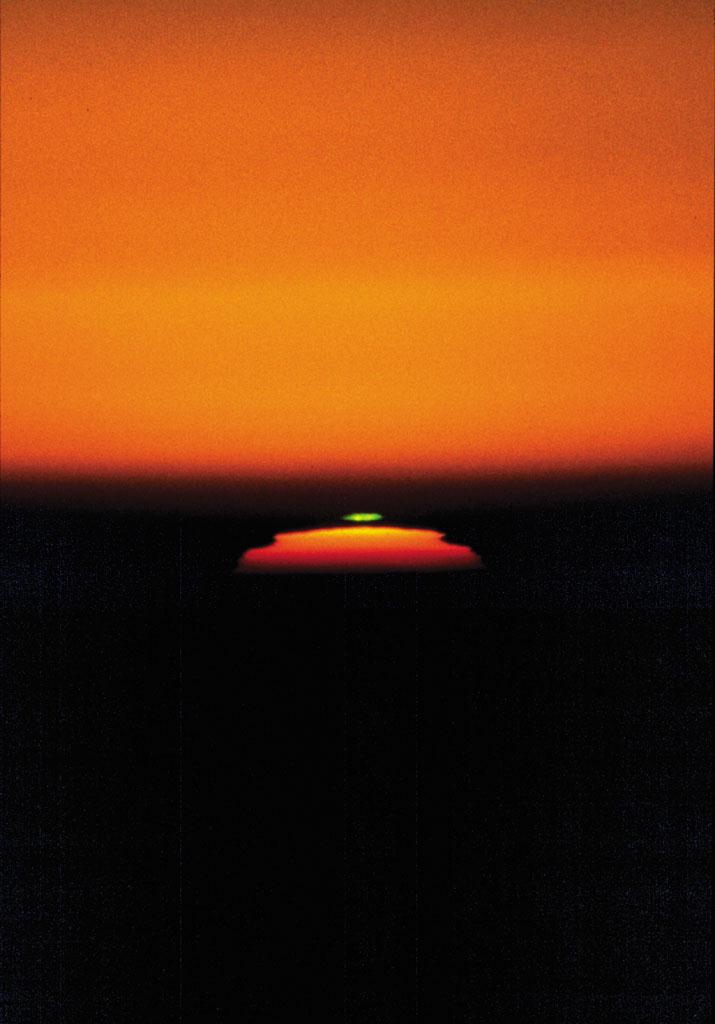
Beautiful mock-mirage flash, photographed by the author on 7 January 1996
from his “usual place” at Torrey Pines. (Torrey Pines is a 100-m high
cliff on the southern California coast, not far from the university in San
Diego.) [[NOTE: there are three universities in San Diego with similar
names: San Diego State University, where I am an adjunct faculty member;
the University of California at San Diego, close to Torrey Pines; and the
University of San Diego, irrelevant here but still confusing!]]
The green flash, celestial phenomenon between ship and shore
Andrew T. Young
Introduction
Green flashes are startlingly beautiful phenomena visible at sunrise and
sunset, in which (at sunset) the upper portion of the Sun's disk suddenly
changes from yellow or orange to an astonishing green color for a second
or two. The color is of nearly spectral purity, and exceeds the ability
of either language or photography to portray accurately; it must be seen to
be appreciated.

Mock-mirage flash, photographed by the author on 18 July 1998.
The sudden color change is due to a combination of atmospheric
scattering, which greatly weakens the blue and violet transmitted near
the horizon; atmospheric absorption, mostly due to ozone, which removes
most of the orange; and the dispersion of refraction, which makes the
red image disappear before the green. At sunset, the bright setting Sun
usually bleaches much of the red-sensitive photopigment from the retina,
so that the image appears green somewhat sooner than it otherwise would;
thus flashes that appear green to the eye often turn out yellow on color
film.
I have been observing green flashes and studying their literature
for several years, and have been impressed by the
disproportionate influence of a few Dutch sailors and scientists.
To my surprise, even some modern Dutch scientists are unaware of their
remarkable heritage in this fascinating subject. To be sure, most people
around the world first learn of green flashes from the account in
Minnaert's wonderful book “Light and Color in the Open Air,” which has
been translated into many languages. But Minnaert's account is based
primarily on the work of two earlier Dutchmen, Marten Edsge Mulder and
Pieter Feenstra Kuiper; and their work, in turn, depended on the studies of
earlier Dutch workers.
This is a brief history of green-flash studies, together with a sketch
of our present understanding of these beautiful and varied phenomena.
The largest body of observations is that sent by Dutch seamen to Prof.
A. A. Nijland; so let us begin with these.
Prof. Nijland and “De Zee”
The story begins with the Dutch expedition to Sumatra to observe the
total solar eclipse of May 18, 1901. Among the members were an
astronomer, Albert Antonie Nijland, and a physicist, W. H. Julius.
On both the trip out to Sumatra and the return journey, they observed
3 green flashes at sunrise, and 4 at sunset. As one might expect
from their training, the astronomer concluded that more observations were
needed, while the physicist concocted a far-fetched theoretical
explanation, which later proved to be worthless. We can forget about
Prof. Julius's “anomalous-dispersion” theory, and concentrate on Prof.
Nijland's remarkable next step.
Nijland realized, from his shipboard observations, that the best place to
observe green flashes was at sea rather than on dry land. So he
published an appeal to seamen in De Zee, saying that
“No one is better placed to collect the data so badly needed about
this phenomenon that is really still unknown and mysterious
than a seaman on morning-watch or dog-watch.”
He then provided detailed instructions for observers.
Many sailors responded to Nijland's appeal, but none so enthusiastically
as Captain Egbertus E. Havinga, who turned in some 450 observations in
the 3 years from Oct. 1902 to Oct. 1905, including almost 300 green flashes.
Having received no response, and having decided “that there was not much
more to discover,” he stopped recording his observations. Besides, as he
explained, “A Steamship Line is no philanthropic institution; there is
work to be done.” Still, in those three years,
Captain Havinga contributed more green-flash observations than anyone
before or since.
Nijland's appeal succeeded, but almost too well: he soon had more
observations than he knew what to do with, and realized that this material
would make a good thesis project for a graduate student. But apparently
no astronomy student was interested in this half-meteorological
phenomenon; and then the War intervened. Two decades elapsed before
Nijland was able to find someone to analyze the great collection of
observations he had collected.
Mulder
Meanwhile, Marten Edsge Mulder, a professor of ophthalmology, had seen a
green flash in 1907, but did not pursue his interest in the phenomenon
until he read an account of a similar observation in the German magazine
Kosmos in 1912. This prompted him to collect everything he
could find about the phenomenon, and finally to publish it in 1922 as the
first book ever devoted to this subject.
In Hemel en Dampkring
19, 129-130 (1922), Mulder remarked that
“The book is written in English because the English, as a seafaring
nation, have made many observations and still show much interest in the
phenomenon.”
Mulder's work is remarkable in several ways. Not only did he collect and
organize the scattered accounts of green flashes; he was able to classify
the observations into three groups, and this scheme has completely
dominated all subsequent work on the subject. Most commendable of all,
he was able to reject his initial impression that his own observation
was an afterimage, and instead to realize that atmospheric dispersion is
the basis of the phenomenon. Few devotees of the “afterimage” theory
have been willing to give it up.
No doubt Mulder's division of green-flash phenomena into the green rim
(which is always visible in a telescope, but never with the naked eye),
the green ray that shoots up from the horizon, and the green segment,
which he believed to be simply the green rim visible after the rest of the
Sun has set, has had the most lasting effect on the subject.
However, the latter category has turned out to be much more complex
than Mulder and his followers imagined; it includes at least three
separate phenomena, none of which is a simple segment cut off by the
horizon.
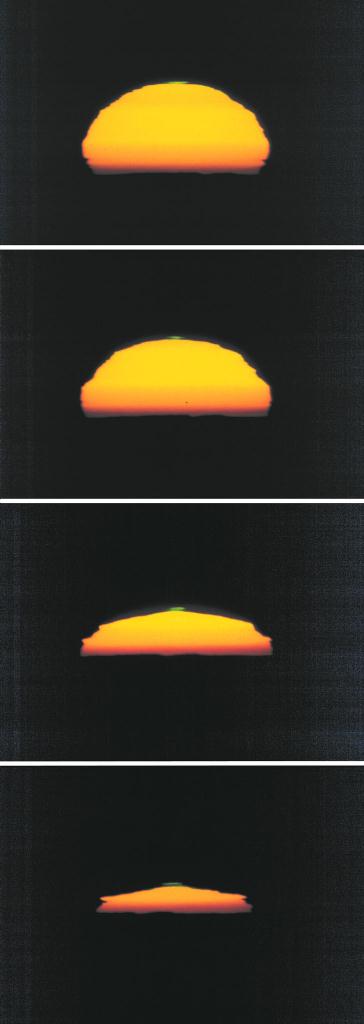 This series of four consecutive (!) green flashes was photographed 20
September 1996 by the author. The photos were taken from Mount Laguna
Observatory, which lies 1620 meters above sea level. Thus, these are
mock-mirage flashes.
This series of four consecutive (!) green flashes was photographed 20
September 1996 by the author. The photos were taken from Mount Laguna
Observatory, which lies 1620 meters above sea level. Thus, these are
mock-mirage flashes.
Feenstra Kuiper
The publication of Mulder's book prompted Havinga to complain that his
work had been neglected, and stimulated Nijland to set a student to work
on the collected observations. The student who finally did this was
Pieter Feenstra Kuiper, whose thesis “De Groene Straal”
[[literally, “The Green Ray”; but we would say “The Green Flash”]]
added hundreds
of observations to the available literature — though not a single one was
made by him. [[However, see the
letter from Cor Booy,
who had a first-hand account of Feenstra Kuiper's green-flash observations.]]
In interpreting this rich material, Feenstra Kuiper relied heavily on
Mulder's book, and on an independent and nearly simultaneous review of the
literature by the American astronomer Willard J. Fisher (to whom I shall
return presently.) In his thesis, Feenstra Kuiper published not only a
summary of hundreds of green-flash observations, but an analysis of
their durations, finding that the typical flash lasts just under 2
seconds. He also noticed that a few flashes — perhaps one in a hundred
— last much longer, with several between 10 and 15 seconds.
Unfortunately, he also misunderstood a work on mirages by Alfred Wegener,
the father of continental drift, and thus misinterpreted one common form
of green flash as due to thermal inversions above the observer. Only
recently have these been explained as due to inversions below eye level.
He also adopted Mulder's somewhat misleading classification scheme.
Finally, on the basis of rather flimsy evidence, he concluded “that a
high humidity is in general favorable for the phenomenon.”
Feenstra Kuiper's thesis came to the attention of Prof. B. G. Escher,
brother of the remarkable artist M. C. Escher. Prof. Escher was a
geologist, so it was natural for him to plot the geographic distribution
of the observations in Feenstra Kuiper's thesis on a map. He immediately
saw “that the frequency of observations … is greatest in the
South-Eastern part of the Mediterranean Sea, in the Suez Canal, in the
Gulf of Suez, in the Red Sea and in the Gulf of Aden.” He
therefore concluded that green flashes are most common “where the
precipitation is the least, i.e. where the shipping routes pass near or
between deserts,” and “that a dry climate is favorable for the
appearance of this remarkable phenomenon.”
This remarkable conclusion is completely in accord with what we know
today: that green flashes are usually by-products of mirages, which are
favored by the large diurnal temperature changes in desert climates,
where the low humidity allows strong radiative cooling at night. But it
contradicted a major conclusion of Feenstra Kuiper.
Furthermore, Escher prefaced his own classification proposal, more
detailed than Mulder's, with the modest apology,
“A complete classification could only be given by someone who has made
very many observations himself and moreover is well grounded in the natural
sciences.”
Feenstra Kuiper apparently took this remark as
directed against himself personally, and angrily responded:
“To observe astronomical and atmospheric phenomena does indeed demand
much routine, and explanations of them, scientific preparation;
but one would expect these sooner from an astronomer and meteorologist,
than from a geologist.” He even went so far as to complain
of “the authoritarian tone” of Escher's paper, which an impartial reader
can hardly discern.
Minnaert
Perhaps if Minnaert had read this exchange, he might have given less
weight to both Mulder's classification and Feenstra Kuiper's claims.
But few astronomers read the proceedings of a Geographical Society.
So Minnaert's account in “Light and Color in the Open Air” is mainly
based on the works of Mulder and Feenstra Kuiper. And, in turn, most
later writers have deferred to Minnaert; indeed, O'Connell (whose book
is regarded by astronomers as the last word on the subject) did not even
read Mulder's book. So the “textbook” account of green flashes today is
largely based on these works.
In any case, it is fortunate that Minnaert chose to reproduce from
Feenstra Kuiper's thesis the remarkable drawing made by D. P. Lagaaij,
showing a “green ray” shooting up from a green flash. This unusual type
of display, similar to a “green column” seen by Escher, is evidence that
things are not so simple as the textbooks would have one believe.
The standard story, which goes back to David Winstanley's 1873
telescopic observations of the green rim, is that normal refraction
separates the red and green images slightly at the horizon, so that when
the red image is just below the horizon, the green rim remains visible.
However, the green rim is only about 1/2 to 1/3 of a minute of arc wide,
which projects to about half the width of a cone in the retina.
[The cones are the light-sensitive cells with which we see colors — Ed.]
Nevertheless, this “green rim” model of green flashes was popular among
astronomers and physicists who had never seen an actual flash, such as the
younger Lord Rayleigh, whose 1930 paper leans heavily on the 1906 account
given by Arthur Rambaut.
As Rayleigh's paper was one of the few cited by Minnaert in his book, it
has continued to be influential. So this model was still put forth by
D. J. K. O'Connell in his 1957 book, “The Green Flash and Other Low Sun
Phenomena,” although it hardly accounts for the color
photographs shown there. (The phrase “low Sun phenomena,” by the way,
was coined by W. J. Fisher.)
In 1955 Gerhard Dietze showed that, in fact, the green rim is too small
and faint to be visible to the unaided eye when it alone is above the
horizon. His paper is much less well known than it should be, because
it was missed by O'Connell, who searched only the astronomical and not
the meteorological literature.
Evershed and Fisher
So, if green flashes are not just a “green segment” cut off by the
horizon, what are they? The first clue is buried in the earliest known
scientific paper on the subject, a note sent by James Prescott Joule to
the Manchester Literary and Philosophical Society in 1869. Joule
casually remarked that “at the moment of the departure of the sun below
the horizon, the last glimpse is coloured bluish green.” But he also
provided a sketch of the setting Sun with little “feet” where it joined
the horizon — a shape likened to the Greek capital letter Omega by the Italian
astronomer Riccò much later.
These “feet” are nothing but a reflected image of the part of the Sun's
disk immediately above them. This reflection is produced by the common
inferior mirage, familiar to everyone today because of its visibility on
asphalt roads on sunny days. This is the mirage of the desert, and of the
sea as well; indeed, the term “mirage” was used by French sailors long
before it entered the technical literature, even in French. Whenever the
water is a degree or more above the temperature of the air, the mirage can
be seen at sea.
Unfortunately, Joule's note is so little known that even O'Connell was
unaware that it was ever published. It remained for the English
astronomer John Evershed to re-discover the connection between the
inferior mirage and Joule's “last glimpse” green flash. Though he
first mentioned the word “mirage” in connection with a green flash in
1915, it was not until 1923 that he began to insist that the two
phenomena are related. “It seems evident,” he wrote, “that the
mirage layer greatly intensifies the ordinary dispersion effect, by
adding the light from the reflected image to the direct image at the
moment of setting. The normal dispersion effect at sunset under
conditions when there is no mirage is scarcely visible to unaided
vision, although easily seen in a telescope of low power.”
Independently, an American astronomer, Willard J. Fisher, was also
connecting mirages with green flashes. It was he who coined the phrase
“low Sun phenomena”
that O'Connell took for the subtitle of his book.
Fisher first became interested in sunset phenomena in the Philippines,
where he noticed that the apparent duration of sunset is sometimes much
longer than predicted from Nautical Almanac data. While carefully
observing sunsets to confirm this fact, he noticed that there are two
distinctly different kinds of marine sunset:
“Type A occurs always when mirage is perceptible … As the
descending sun, vertically compressed by atmospheric refraction,
approaches the sea horizon, a protuberance … grows out below, and
almost simultaneously a line of light appears in the sea horizon, which
lengthens horizontally and thickens upward till the protuberance and the
thickened line join … For about half the duration of sunset the sun
presents the appearance of an inverted fish globe, whose mouth widens to
the sun's diameter; from then on the vanishing disk looks like an
ellipse much flattened below, and vanishes as a small oval spot…
This spot does not sink below the horizon; it `goes out,' above it.”
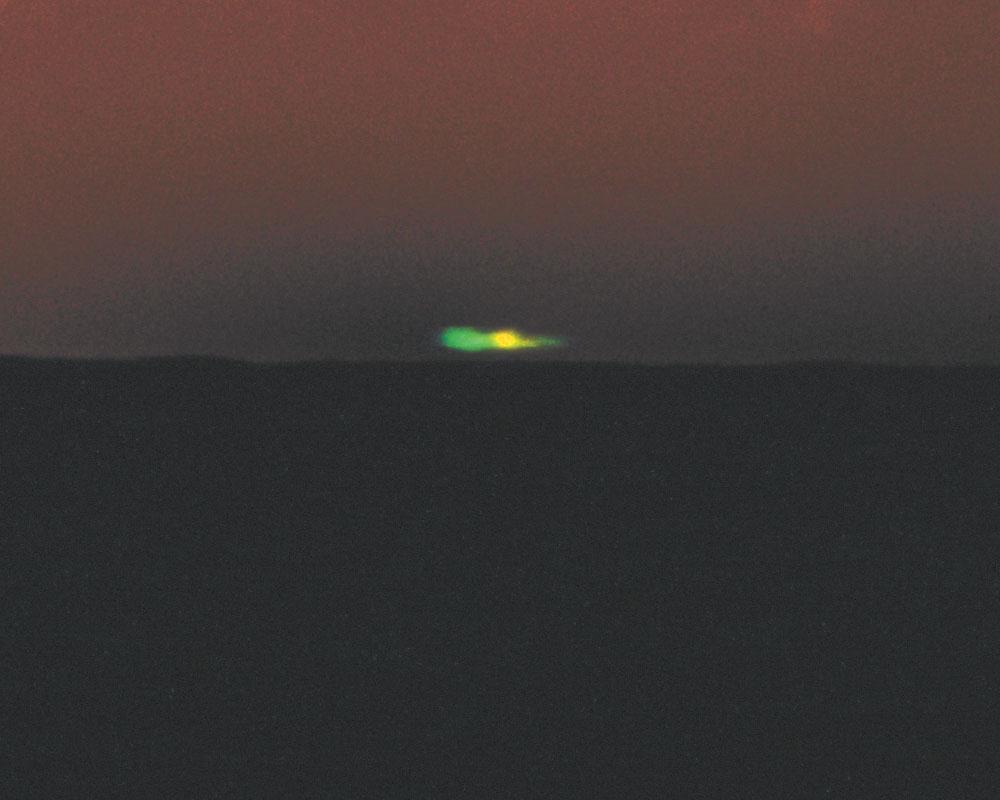
This inferior-mirage flash was seen on 30 March, 1998,
at Scripps Pier (Southern California), a place that lies about eleven
meters above sea level. Notice the (disappearing) yellow spot in the
middle of the green flash. This is the kind of green flash that can be
seen from the Low Countries. [[NOTE: this image is highly magnified.
For a comparison with an earlier stage in this same sunset that shows the
full disk of the Sun, click
here. I have also
added an
animation
of such a sunset since this paper was written; and, more recently,
simulated images
with more realistic colors.]]
“Type B never occurs simultaneously with a perceptible mirage. The
descending sun flattens below as it approaches the horizon, which is not
easy to see under it, being comparatively dark. The corners of the disk
as it passes below the horizon are rounded, instead of projecting, until
about midsunset; then the remaining segment begins to show a rim, so
that it looks for a time not unlike the `tin hat' or trench helmet of
the American Expeditionary Force. This flattens down in the middle
faster than it shortens horizontally, becomes a line of light and
disappears in dots and dashes among the waves, if the horizon is near.
The disappearance is slow, not like the vanishing of the spot at the end
of type A.”
Fisher soon found that green flashes were common in type A sunsets and
rare in type B. However, he seems not to have understood the mirage
effect in detail. What happens is that the inverted image of the mirage
blends smoothly into the erect image above it; at the line where they
join, there is infinite vertical magnification. The large vertical
stretching of the image near this line expands the normally invisibly
thin green rim into a fat blob, often several minutes of arc in vertical
span. The lower part of this blob is, of course, the inverted image of
the upper part, reflected in the mirage. [[In fact, if one assumes the
temperature profile prescribed by the Monin-Obukhov similarity theory of
boundary-layer meteorology, all the features described by Fisher (and
many others) are beautifully reproduced.]]
Though Fisher was aware of the connection between mirages and warm
surfaces, he did not explicitly connect his type A and B sunsets with the
difference in temperature between water and air. However, Captain Havinga
did. He independently had noticed the difference between the two types of
sunsets, and explicitly stated that “… when the temp. of the air is
lower than that of the water, and the Sun is a few min. [[of arc]] above
the horizon, a counter-Sun rises; the Sun sinks, the counter-Sun rises,
they fuse together and the Sun takes on the so-called balloon-form.
But the last little segment disappears not with sharp corners on
the horizon, but as a little ellipse a few min. above the horizon.”
Like Fisher and Evershed, he
recognized that this type of sunset favors green flashes.
The computer simulations depicted here give an overview of the course of
the most important green-flash phenomena. From top to bottom are the
inferior-mirage flash, the mock-mirage flash, and the sub-duct flash.
The figures show only the (mostly overlapping one another) contours of the
Sun for wavelengths of 530 nm (“green”) and 700 nm (“red”); the
astronomical horizon is marked by a dashed line, and the apparent horizon
by a solid line. [[The scales at the sides are in arc minutes; the number
below each sub-panel is the true altitude of the Sun's center at the time
for which the outlines are shown.]]
The [[transfer-curve]] graphics following the simulations illustrate how
light of these two wavelengths are refracted differently by the
atmosphere; the true altitude above the horizon is plotted against the
apparent altitude. The divisions on the axes are in arc minutes.
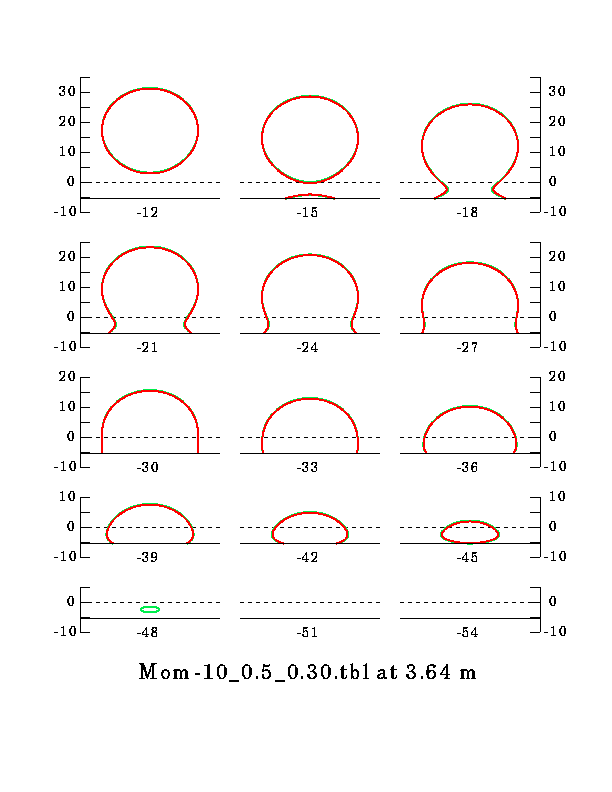
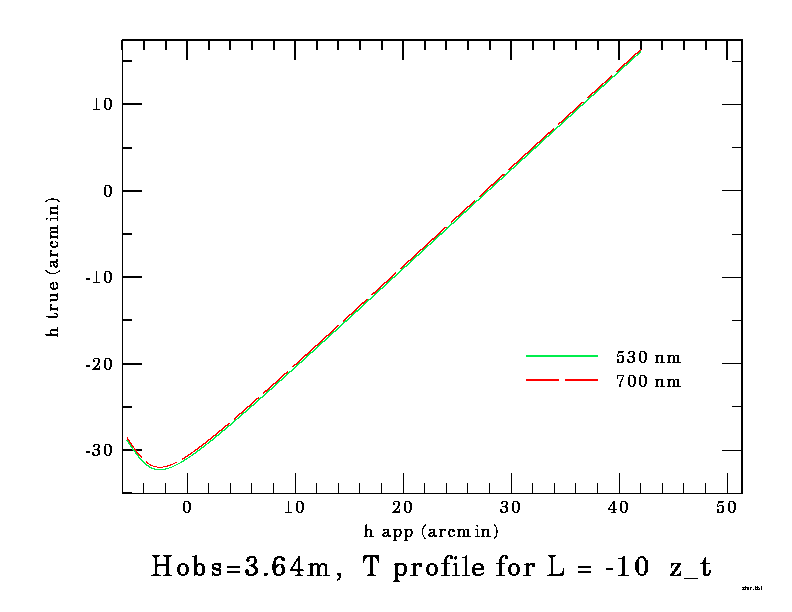 [[On p.252 of my Zenit article, the three kinds of flash are all
shown together for comparison, with the transfer curve for each flash
beside its simulation; but the limited resolution of computer screens
makes that impractical here. So I show the inferior-mirage flash and its
transfer curve above, and place the other two flashes in the text below,
closer to where they are discussed. See also the
sidebar from the article.]]
[[On p.252 of my Zenit article, the three kinds of flash are all
shown together for comparison, with the transfer curve for each flash
beside its simulation; but the limited resolution of computer screens
makes that impractical here. So I show the inferior-mirage flash and its
transfer curve above, and place the other two flashes in the text below,
closer to where they are discussed. See also the
sidebar from the article.]]
Other kinds of green flash
If the green flash produced by the inferior mirage were the only kind of
green flash, the subject would have been much less confused. There are
actually 5 or 6 kinds of green flash, however. The second most common
one was described in the last sentence of Joule's letter: “Just at the
upper edge, where bands of the sun's disk are separated one after the
other by refraction, each band becomes coloured blue just before it
vanishes.”
This type of flash accompanies a recently-understood phenomenon I have
called a “mock mirage.” Unlike the classical inferior and superior
mirages, which can crudely be thought of as caused by internal reflection
at a less-dense layer of air, the mock mirage is a purely refractive
phenomenon. When a thermal inversion lies below eye level, the
denser air below it acts like a big, weak lens. Near grazing incidence,
this lens has enough power to form an inverted image of a strip of the
sky beyond it. This inverted strip of sky can produce a double image
of the limb of the Sun. When the bottom edge of the Sun reaches this
double-image almucantar, an elliptical red flash appears below the main
solar image; when the upper limb reaches it, a sharp-cornered strip
appears to separate from the limb and turn green before vanishing.
The mock-mirage flash:

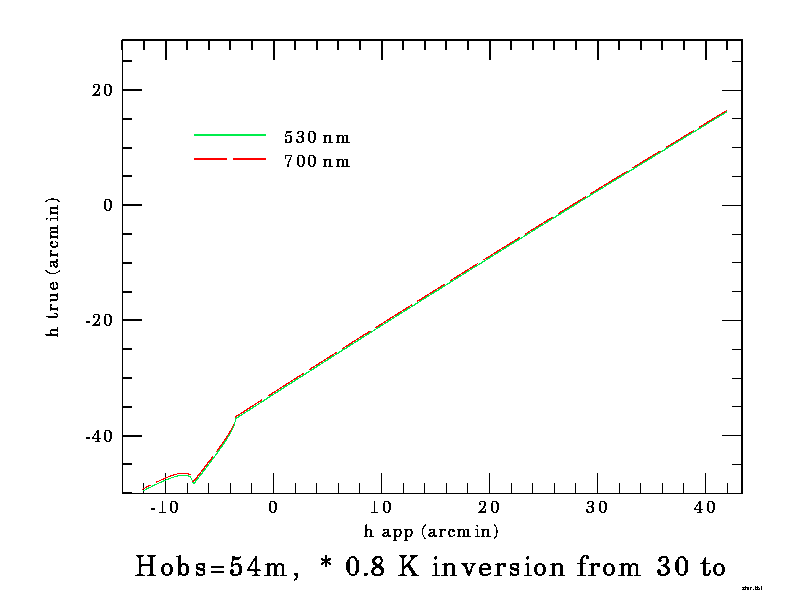
These flashes can be much longer-lasting than the inferior-mirage flash.
There are reliably timed observations as long as 15 seconds; I myself have
seen a 5-second flash. However, as they require appreciable thermal
structure below eye level, they are rarely seen near sea level; most
observations are from cliffs or seaside hills at least some tens of
meters high. Consequently, most of the phenomena in O'Connell's book,
which were photographed from Castel Gandolfo, 450 meters above the sea,
are of this type. They are also commonly seen from mountain observatories
in Mediterranean climates, such as those on the western coasts of the
Americas.
In contrast, the inferior-mirage flash is best seen from heights on the
order of 3 to 5 meters, and gradually become more compressed and less
conspicuous at considerable heights. Thus, the deck of a ship is nearly
ideal for observing inferior-mirage flashes; so these dominate the list in
Feenstra Kuiper's thesis. Hence, most of the flashes seen in the Low
Countries correspond to Joule's “last glimpse” of the setting Sun.
There are still other varieties of flash, most of them associated with
optical ducts, which we have no room for here. But Mulder's “green ray”
type of display deserves a few words, as these are occasionally seen from
near sea level. There are several very reliable accounts of these
phenomena, which I believe are crepuscular rays in hazy air illuminated by
an unusually large green flash. The ray is formed by forward scattering
by the haze particles; if it passes just above the observer's head, it can
appear to “shoot up” from the horizon, as described by Mulder, Escher,
and others.
Graph of the temperature profile of a “duct” in the atmosphere,
when the sub-duct flash is produced (below). Here a temperature inversion
of 2 degrees is assumed, which extends from 50 to 60 m height.
The observer should be at a height of 45m to see the flash, simulated
below.
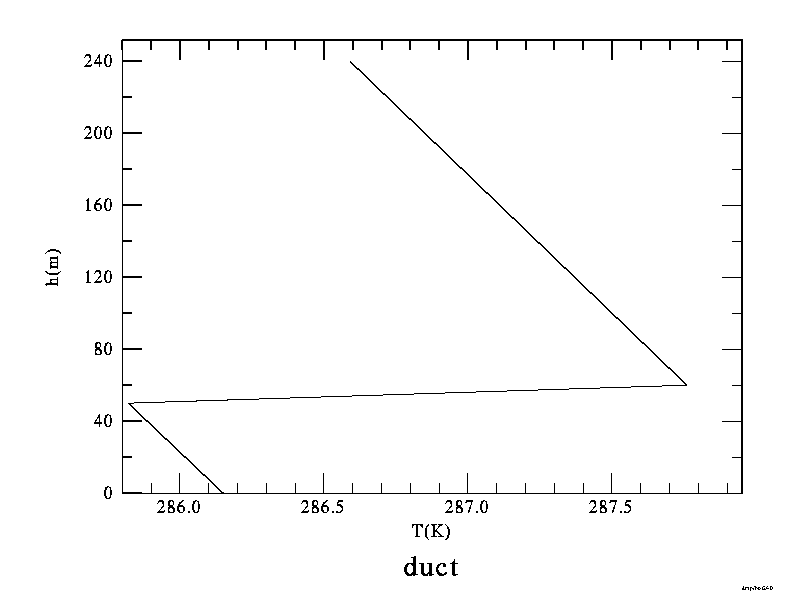
The sub-duct flash:
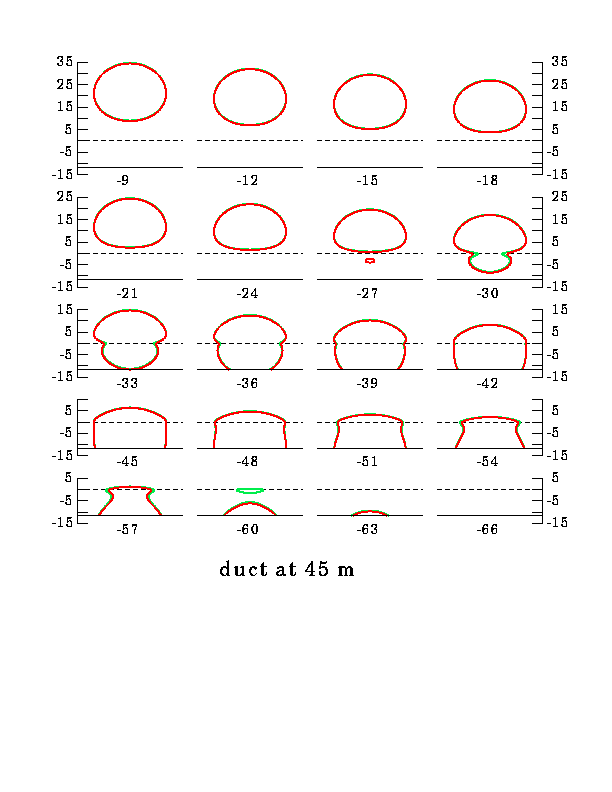
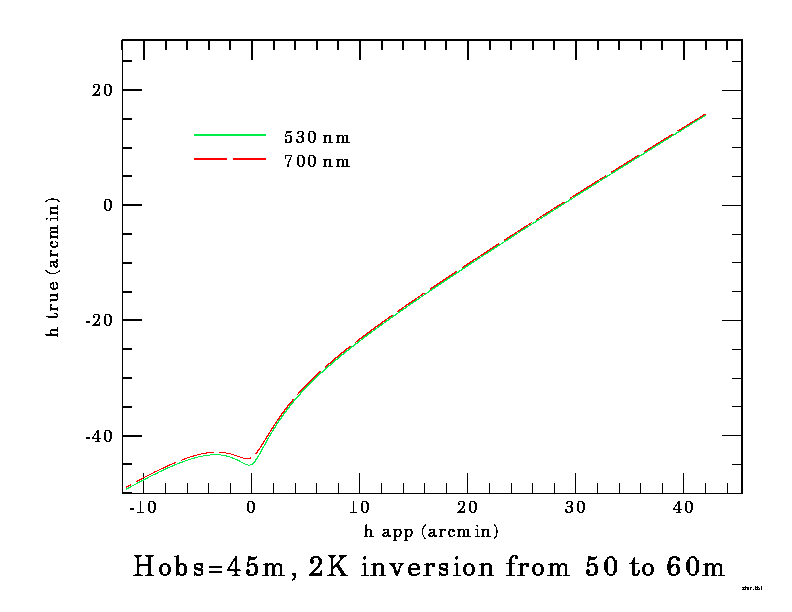
Conclusion
Considering the complexity of green flashes, with several different forms,
each having its own distinct optical mechanism, and the color of each
being produced by a combination of refraction, dispersion, scattering,
absorption, and (at sunset) the partial bleaching of photosensitive
pigments in the retina, it is no wonder that our understanding of these
phenomena remains incomplete. Because of the complexity of forms and
mechanisms, understanding is possible only when all the various types are
treated separately; and, as Escher pointed out, this classification is
only possible when one has seen many different green flashes.
Alas, no one person can see all the variety made possible by different
geographical settings and climates. So I have found it absolutely
essential to read as many first-hand accounts of observations as possible.
Captain Havinga, probably the all-time champion observer of green flashes,
once complained that the trouble with most accounts is that “All the
letter-writers have heard of the green flash now and again, don't
know what and how much has already been written about this
subject, have seen the phenomenon a single time and suppose that they have
made an important discovery worth reporting.”
It is ironic that if everyone had taken this remark to heart, we would
not have the great body of independent observations that exist today.
Although observations from experienced observers are much more useful
than those of a first-timer, it is also true that most of the rare forms
of flash are reported by first-time observers (like Mulder, with his
green-ray observation). Such remarkable and well-established phenomena
as green-ray displays, and flashes lasting over 5 seconds, which make up
only about 1 per cent of all green-flash reports, would not be known if
everyone took a conservative attitude toward publication.
The complexity of the subject makes simplistic explanations, such as
those found in the textbooks, quite inadequate. The slow understanding
of green flashes is thus partly due to the difficulty of assimilating
all the different disciplines that are involved: astronomy, meteorology,
hydrography, atmospheric optics, physiological optics, and others. As
Cornelis said of the related problem of great refraction at high
latitudes, “Through the division among all sorts of professions
and specialties the refraction has been lost in the crowd. The
meteorologists leave the teaching to the astronomers, but these
have basically an abhorrence of everything close to the Earth, and are
concerned with refraction only when it has an insignificant value.
Also the meteorologists are hardly attracted by the so-called
terrestrial refraction, because it is parcelled out by the
compartmentalization to geodesy, while the geodesists have not extended
their activities to the polar seas.”
So it is with green flashes; no field
wants to “own” them, so they have fallen through the cracks.
[[This was the phrase that Eddy Echternach
ingeniously translated as “tusschen wal en
schip” — literally, “between shore and ship”. So his version of my
original sentence says literally: “So it is with the green flashes: they
belong nowhere and have literally fallen between shore and ship.”]]
Further progress depends on more and better observations today, just as
it did when Prof. Nijland appealed for observations. Visual
observations by experienced observers are still useful; however,
binoculars should be used, as most flashes are too small to be seen by
the naked eye. Today, color photography makes possible permanent,
accurate records of sunsets. Green flashes are usually small, so a long
telephoto lens should be used. We still need photographs of green-ray
displays and other unusual flash phenomena, such as the very large
and/or long-lasting flashes that seldom occur. An educated amateur can
still contribute to scientific research in this field, so I encourage
everyone to become familiar with the common green flashes, and to watch
for what Mulder called the “rare and abnormal forms” that have yet to
be understood.
The author thanks the Atmospheric Sciences Division of the U. S. National
Science Foundation for their financial support of the green-flash
research. [[Dutch]] translation: Eddy Echternach
References
A. A. Nijland, “Over den `groenen straal' en eenige andere
hemelverschijnselen,” De Zee 24, 60-68 (1902)
E. Havinga, “De groene straal,” Hemel en Dampkring 19,
161-165 (1922)
Prof. Dr. M. E. Mulder, “De groene straal en de groene branding,”
Hemel en Dampkring 19, 129-130 (1922)
Prof. Dr. M. E. Mulder, “The “Green Ray” or
“Green Flash” (Rayon Vert)
at Rising and Setting of the Sun,”
(T. Fisher Unwin, Ltd., London, 1922)
Pieter Feenstra Kuiper, “De Groene Straal”
(C. de Boer Jr., Helder, 1926)
B. G. Escher, “De Groene Straal,”
Tijdschr. Kon. Ned. Aardr. Gen. (2) 47, 602-609 (1930)
P. Feenstra Kuiper, “De Groene Straal,”
Tijdschr. Kon. Ned. Aardr. Gen. (2) 47,868-870 (1930)
M. Minnaert, “The Nature of Light and Color in the Open Air,”
(Dover, New York, 1954)
[ EDITORS: You will probably want to cite the Dutch edition:
“De natuurkunde van't vrije veld door M.Minnaert”
(Thieme,Zutphen, 1937) — or perhaps a later one. ]
David Winstanley, “Atmospheric Refraction and the last rays of the
Setting Sun,” Proc. Manchester Lit. Phil. Soc. 13,
1-4 (1873)
Lord Rayleigh, “Normal atmospheric dispersion as the cause of
the "Green Flash" at sunset, with illustrative experiments
Proc. Roy. Soc. A 126, 311-318 (1930)
A. A. Rambaut, “The green flash on the horizon,”
Symons's Met. Mag. 41, 21-23, 41-45 (1906)
D. J. K. O'Connell, “The Green Flash and Other Low Sun Phenomena,”
(North Holland, Amsterdam, 1958)
G. Dietze, “Die Sichtbarkeit des `grünen Strahls',”
Zeitschr. f. Meteorologie 9, 169-178 (1955)
J. P. Joule, “On an appearance of the setting sun,”
Proc. Manchester Lit. Phil. Soc. 9, 1 (1869)
J. Evershed, “The green flash at sunset,” Nature 111, 13 (1923)
W. J. Fisher, “Low-Sun phenomena in Luzon III. Marine sunsets and
the duration of sunset on Manila Bay and the China Sea,”
Philippine J. Sci. 17, 607-614 (1920)
W. J. Fisher, “Low-Sun phenomena — IV. The `Green Flash' ”
Pop. Astron. 29, 251-265, 382-392 (1921)
A. T. Young, G. W. Kattawar, P. Parviainen, “Sunset Science.
I. The Mock Mirage,” Appl. Opt. 36, 2689-2700 (1997)
E. Havinga, “Groene straal en kimduiking,”
Hemel en Dampkring 32, 114-118 (1934)
W. Cornelis, “Het Nova-Zembla-verschijnsel,”
De Zee 46, 194-201 (1924)
You might also like to read the translation of a
letter from Cor Booy that was published in response to
this article. He tells a wonderful story about Feenstra Kuiper, who gave
lectures in the 1950s that Mr. Booy attended.
© 1999, 2006, 2014 Andrew T. Young

 [[On p.252 of my Zenit article, the three kinds of flash are all
shown together for comparison, with the transfer curve for each flash
beside its simulation; but the limited resolution of computer screens
makes that impractical here. So I show the inferior-mirage flash and its
transfer curve above, and place the other two flashes in the text below,
closer to where they are discussed. See also the
sidebar from the article.]]
[[On p.252 of my Zenit article, the three kinds of flash are all
shown together for comparison, with the transfer curve for each flash
beside its simulation; but the limited resolution of computer screens
makes that impractical here. So I show the inferior-mirage flash and its
transfer curve above, and place the other two flashes in the text below,
closer to where they are discussed. See also the
sidebar from the article.]]


 This series of four consecutive (!) green flashes was photographed 20
September 1996 by the author. The photos were taken from Mount Laguna
Observatory, which lies 1620 meters above sea level. Thus, these are
mock-mirage flashes.
This series of four consecutive (!) green flashes was photographed 20
September 1996 by the author. The photos were taken from Mount Laguna
Observatory, which lies 1620 meters above sea level. Thus, these are
mock-mirage flashes.





